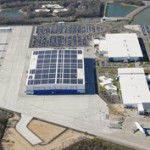Natural gas fell on Friday and settled the week lower as a larger-than-average build in US natural gas inventories offset weather forecasts calling for seasonal and little-above seasonal readings across most of the US in the coming weeks. Market players also eyed tropical cyclone Arthur.
On the New York Mercantile Exchange, natural gas futures for settlement in August fell by 0.89% to $4.367 per million British thermal units on Friday, having shifted in a daily range between $4.402 and $4.341 per mBtu. The energy source added 1.1% on Thursday after it had plunged to a 3-month low of $4.329 earlier in the day, but settled the week 0.9% lower.
The Energy Information Administrations weekly natural gas storage report revealed a 100-billion cubic feet gain in nationwide US inventories in the seven days through June 27th, well above the average gain, but in line with expectations. According to NatGasWeather.com, stockpiles were projected to have increased in the range between 99 and 103 billion cubic feet, while the five-year average build for the respective period was 78 bcf.
Inventories in the East Region received a net injection of 65 bcf and were 28.4% below the average, while the West Region added 16 bcf to stockpiles, bringing the deficit to the 5-year average to 22.5%. In the Producing Region, inventories rose by 19 billion cubic feet to 675 billion and were 32.8% beneath the average.
Total gas held in US underground storage hubs amounted to 1 929 billion cubic feet, which was 25.7% below the comparable period a year earlier and 29.1% beneath the five-year average for the same week. However, the Energy Information Administration had forecast that injections will continue to be mostly above-average during the replenishment period through October, implying that stockpiles will be fully refilled ahead of the heating seasons start.
Weather outlook
NatGasWeather.com reported on Thursday that the high pressure build-up over much of the western and southern US will keep temperatures relatively high, reaching above 100 degrees Fahrenheit in many places. A cooler weather system will track through the Midwest and Northeast, bringing showers and clouds and dragging readings down a few degrees, before readings rise again early next week. However, another Canadian weather system will follow mid-week and will attempt to push across the border, carrying cooler air. Tropical Cyclone Arthur remains impressive and could drive some market fear, though the high pressure over the Midwest should push the storm offshore. Cooling demand is projected to be moderate-to-high.
In the 8-14 day outlook, NatGasWeather.com projected a neutral trend for the US, with an upward bias. The southern and central, as well as the western states will be relatively warm for the whole period, with the northern and eastern states experiencing some cool conditions early on, though following suit with heat soon after. Thunderstorms will increase over the South and Southwest as the monsoon season begins due to hot temperatures and high humidity.
According to AccuWeather.com, temperatures in New York on July 8th will peak at 92 degrees Fahrenheit, 8 above the usual, but will fall to seasonal over the following seven days, before surging back into the 90s on July 17th. The high in Chicago on July 8th will be 79 degrees, compared to the average of 85, and will be accompanied by thunderstorms. Chicago will enjoy mostly seasonal or little-below-seasonal weather in the following couple of weeks before temperatures jump to 3-4 degrees above normal between July 20th and 24th.
In the South, Houston will see readings peaking at 92 degrees Fahrenheit on July 8th, matching the average, followed by several very sunny and hot days. Temperatures on July 12th will peak at 95 degrees Fahrenheit, before easing to seasonal values through July 19th. The remainder of the month is expected to be very hot with above-normal readings in the upper 90s. On the West Coast, the high in Los Angeles on July 8th will be 79 degrees, 4 beneath the usual, but a hot weekend will follow with temperatures peaking at 87 degrees on July 13th, before easing back to seasonal levels in the following days.
Technical view
According to Binary Tribune’s daily analysis for Monday, in case natural gas for settlement in August penetrates the first resistance level at $4.399 per million British thermal units, it will encounter next resistance at $4.431. If breached, upside movement will probably attempt to advance to $4.460 per mBtu.
If the energy source drops below its first resistance level at $4.338 per mBtu, it will see support at $4.309. If the second key support zone is breached, the power-station fuel’s downward movement may extend to $4.277 per mBtu.





